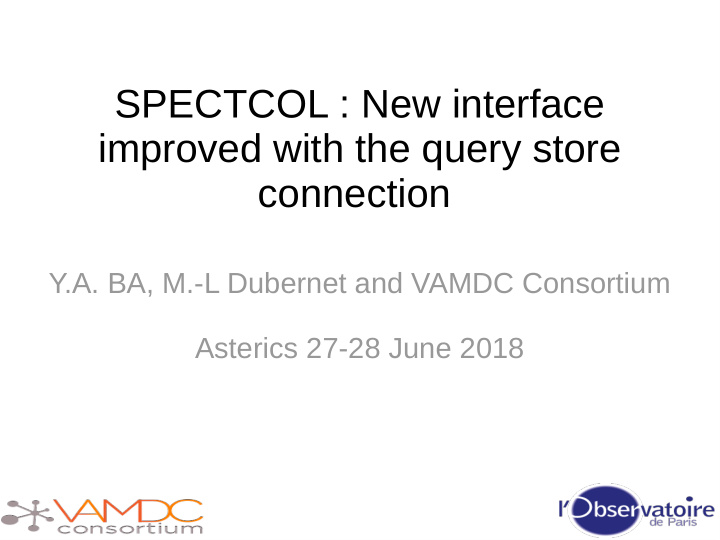



SPECTCOL : New interface improved with the query store connection Y.A. BA, M.-L Dubernet and VAMDC Consortium Asterics 27-28 June 2018
SPECTCOL ● A graphical tool implemented in JavaFx. ● Manipulates and combines spectroscopic and collisional data coming from the Databases (CDMS, JPL, BASECOL, HITRAN,...) using VAMDC technology. ● Manipulates and provides methods to convert XSAMS(Xml Schema for Atoms, Molecules and Solids) data into other formats (CSV, RADEX, LTE). ● Interoperability with other VO-tools (Topcat) ● Connection with the query store http://www.vamdc.org/activities/research/software/spectcol/
SPECTCOL main panel Search Import Panel Panel Selected database Spectroscopic data results Buttons to Manipulate Collisional data data results
SPECTCOL : Interoperability Spectcol can send data table with SAMP (which was easily integrated) ● Data are sent in VO-Table format ● All tables (Energies, Einstein coefficients, Rate coefficients and Partition functions) can be sent to any tool accepting VO-Table such as TopCat
Use case (1): Plot CO Einstein Coeff. with TopCat 1. Select a database (ex : CDMS)
Use case (1): Plot CO Einstein Coeff. with TopCat 2. Select the transition process and Search a molecule (ex : CO) 4. Display Einstein table 3. Select a spectroscopic dataset
Use case (1): Plot CO Einstein Coeff. with TopCat 5. Launch TopCat first and send it Einstein table
Use case (1) : Plot CO Einstein Coeff. with TopCat
SPECTCOL : Automatic data citation Spectcol can communicate with the query store and show data citation. ● Retrieve the query token generated by the node. ● Make an association with the query store and get the UUID ● Get the citation linked to the UUID
Use case (2) : Data citation Same procedure than the spectroscopy to search collisional data : 1.Select the new BASECOL database 2.Search the collision CO-HE 3.Select a dataset 4.Display the link of the citation
Use case (2) : Data citation Copy the link in a browser Get data citation
SPECTCOL : Matching data Spectcol can combine the spectroscopic and collisional data. ● Query both databases : spectroscopic and collisional databases. Ex: Basecol and JPL ● Select a dataset of each of them ● Select the quantum numbers and let spectcol do the job
Use case (3) : Matching data 1. query databases and select 2. Select the datasets « group by species» Or « group by hand » buttons 3. Choose the quantumnumbers
Use case (3) : Ouput Spectroscopic data Collisional data XSAMS File Radex File Ascii File
Contact ● Contact : yaye-awa.ba[at]obspm.fr or marie- lise.dubernet[at]obspm.fr ● VAMDC Consortium website : http://www.vamdc.org/ Thank you
Recommend
More recommend